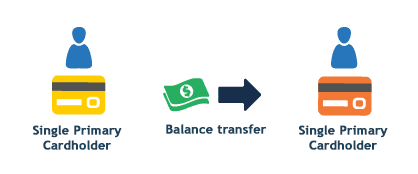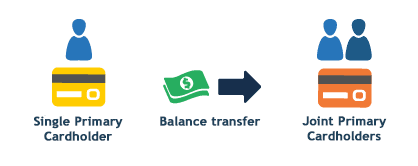Transferring a balance from your existing credit card to a new credit card with a low promotional interest rate is a common way to tackle your debt. What’s less common, though, is getting a balance transfer credit card to help cover a partner or family member’s debt.
There are typically two ways to do a joint balance transfer:
- Transferring debt using two names
- Creating a joint account for the debt
Transferring between accounts involves moving your balance to a new balance transfer credit card with your partner or family members’ name attached.
Our guide outlines the different options you have to make a joint balance transfer so that you can find the best way to deal with shared debts. We also provide information on banks in Canada that allow this process and the steps to take to transfer a credit card debt from your partner or family member’s card to your new joint balance transfer credit card.
How to conduct a balance transfer for someone else’s debt
Financial institutions have two main options if you want to transfer someone else’s balance to an account under your name. These options are:
Transferring the balance between two people’s names
With this option, you would transfer the debt from your partner’s credit card to your own credit card. Their name would be removed from the debt and replaced with yours. This means you’re the only person legally responsible for the balance. In some cases, credit card issuers will require you to add your partner as an “additional cardholder” before their debt can be transferred to the new credit card. Otherwise, you may simply be able to transfer the balance from any person’s account to your own.

Joint accounts for the debt
Some credit cards and other loans will allow you and your partner to apply for a joint account. This option means that you and your partner would share the legal responsibility for the account and any balance that you transfer onto it.
To get a joint credit card account, both of you would provide your details when applying for the balance transfer credit card. Depending on the issuer, you may also request that your partner is added as a joint account holder after you have applied for the card.

The process of transferring your partner’s balance to a new card depends on which option you choose and the credit card you want to use for the balance transfer.
Check out our comprehensive guide to balance transfer credit cards
How to transfer a balance from your partner’s account to your credit card
Most credit card issuers only allow one primary cardholder, transferring the debt from your partner’s debt to your credit card is probably the most likely option.
While qualifications and application process vary between credit card providers, the following steps can be used as a general guide when transferring someone else’s debt to a balance transfer credit card in your name. Get in touch with the institution you’re applying with for more information.
- Compare credit cards. Compare balance transfer credit cards to find one that has a competitive APR and even a 0% promotional period. Make sure it has a credit limit that can support your balance and that you can pay the balance before the promotional period is up. And, remember that some issuers only allow you to transfer up to a percentage of your credit limit.
- Check the balance transfer terms and conditions. Make sure the credit card allows balance transfers between different account names, and if your partner will need to be a secondary cardholder. Check the card’s disclosure statement or call the issuer for more information.
- Apply for the credit card. Provide details including your full name, Social Security number, address, drivers licence or passport number and employment details.
- Include details of the balance transfer. You will need to provide details of the account, including your partner’s name and contact info, the account number, the financial institution’s name, and the amount of debt to be transferred.
- Include details of secondary cardholders. If the issuer requires your partner to be a secondary cardholder to process the balance transfer from their account to your new credit card, fill out this section of the application with your partner.
- Submit the application. You should get an initial response within a few minutes. If you get conditional approval, follow the steps outlined by the issuer to complete the application process and finalize the balance transfer.
Once this process is successfully completed, you should receive your new credit card within 5 to 10 business days, although it could take up to 21 days in some cases. After you activate the new card, the issuer will process the balance transfer.Stay in touch with the new issuer and be ready to answer any questions or provide supporting documentation if needed to help the transfer run as smoothly as possible.
How to complete a balance transfer to a joint primary cardholder with a partner
With some credit cards, it’s possible to transfer a balance from a joint account, or to transfer your partner’s credit card debt to a new joint credit card account. The important thing to remember is that not all credit cards or issuers allow you to have a joint credit card account, so make sure you choose a card that offers this feature.
- To transfer a balance from an existing joint account
Apply for the credit card and include details of the balance transfer request, including all the names of the joint account holders, the account number, financial institution and the amount of debt you want to transfer. You can go through this process with an individual credit card in your name, or apply for a credit card that offers joint account status for you and your partner.

- To transfer a balance from your partner’s account to a new joint credit card account
Find a credit card issuer that allows joint primary cardholders and compare their balance transfer credit cards. Depending on the issuer, you’ll either get joint account status immediately or apply as an individual and add your partner.

What is the difference between joint-primary cardholder accounts and secondary cardholders?
The difference can impact your balance transfer options — and your legal rights — when transferring or sharing debt.
| Joint-primary cardholder accounts | Primary cardholder accounts with secondary cardholders |
|---|---|
Two people have applied for a credit card under both cardholders’ names and have complete access to the account. | One person has applied for a credit card in their name but wants to share the account with a partner (without joint account status). |
Both have the ability to change credit limits, request account freezes or close the account. | Primary cardholder can request to add a secondary or additional cardholder but only the primary cardholder has control over credit limit changes, account freezes or account closure. |
Both partners have regular sources of income and good credit histories. | Only the primary cardholder has to have a regular source of income and a good credit history. |
Both parties remain liable for all transactions and payments made on the card. | Primary cardholder remains liable for all transactions and payments made on the card, even if a balance has been transferred from an account held by the secondary cardholder. |
If the closure of an account is the result of a divorce or a separation, both partners might have to pay half of the debt each, no matter who made which purchases. | In the event of a separation or a divorce, know that you, as the primary cardholder, would be liable to make payments toward the entire account. |
Mistakes to avoid when transferring a balance from someone else’s card
Whether it is your own debt or your partner’s, balance transfer credit cards can be a way to save money on interest and pay down the balance faster. But there are some risks involved. Being aware of the following mistakes will help you make an informed decision about balance transfers for you and your partner when you want to consolidate credit card debt.
- Don’t accidentally apply for a card that doesn’t allow balance transfers from someone else’s account. Not all credit cards let you transfer another person’s credit card debt to a new card in your name. Make sure you check these details before you apply to avoid a declined application.
- Not discussing payments with your partner. If your partner becomes a secondary cardholder on your account, or if you apply for joint account status, it’s important to be clear on how and when you’ll make payments. Discussing this before you apply for a new card or balance transfer reduces the risk of confusion or other issues down the road.
- Not checking the revert rate. The low balance transfer interest rate is only available during the introductory period on the card. When this period ends, any outstanding debt from a balance transfer will attract a higher, standard interest rate until it’s paid off in full.
- Balance transfer fees. You might have to pay a balance transfer fee that can vary from one card provider to the next.
How does a joint balance transfer affect my credit score?
Your credit score is determined by a number of factors — and impacts your ability to get a loan or other credit cards. When you decide to take on more debt through a joint balance transfer, one thing’s for certain — your credit is impacted.
Transferring debt can raise your debt-to-income ratio and lower your credit utilization ratio — which weighs how much debt you have compared to have much credit you have available. Both can lower your credit score and affect your ability to qualify for low APRs.
Making regular, on-time payments also will affect your credit score. It’s important to know who’s responsible for making payments and when the due date is. Some credit card companies charge high fees for late payments, while others will end a low introductory rate.
Bottom line
While it’s hard to find information about transferring a balance from your partner’s accounts to a new credit card, it’s possible under some circumstances. Understanding the different options available and the varying conditions of credit card issuers means you can now find a balance transfer credit card that fits the needs of you and your partner when you want to deal with debt.
Frequently asked questions
More guides on Finder
-
Balance transfer credit card calculator: How much can you save?
Calculate your interest savings with our free balance transfer credit card calculator.
-
Can I balance transfer a personal loan to a credit card?
Find out how to move your debt from a personal loan to a credit card.
-
Balance transfer credit cards that come with rewards
With a balance transfer and rewards program credit card, you can experience the best of both worlds. Get rewards while paying off your debt.
-
Steps to managing your debt with a balance transfer
You’ve conducted a balance transfer, so now what? Follow these easy steps to manage your debt repayment and get the most from your balance transfer promotional offer.